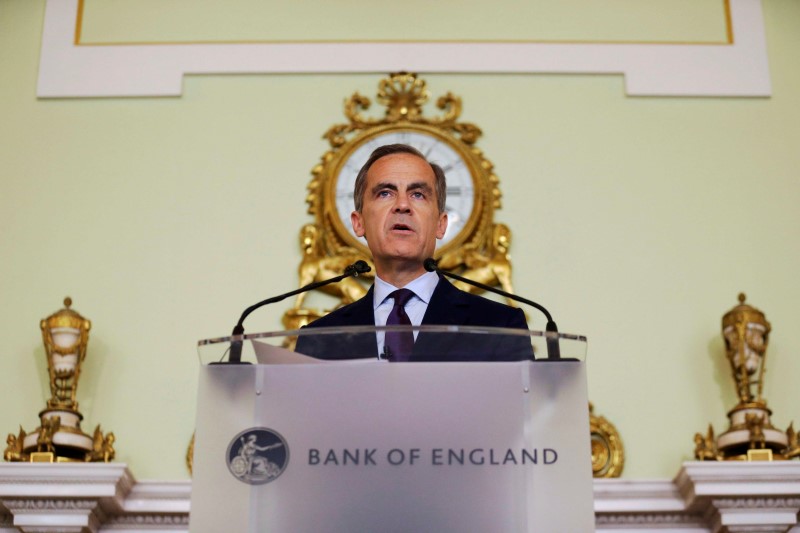Investing.com - Global financial markets will focus on this week's Bank of England policy meeting, for further details on when the central bank plans to raise rates again.
Staying on the central bank front, traders will pay close attention to monetary policy decisions from the Reserve Bank of Australia and the Reserve Bank of New Zealand.
Recent chatter that the world's leading central banks will start tightening monetary policy faster than previously thought has sparked a global bond market selloff this year, with yields in the U.S., Europe and Asia all spiking higher.
Elsewhere, it will be a quiet week for the U.S. and the euro zone with only a handful of relatively unimportant data releases.
Instead, market participants will be looking ahead to monthly trade figures out of China amid recent signs that momentum in the world's second largest economy remains strong.
Meanwhile, in Canada, traders will focus on monthly employment data for further hints on the health of the economy and the likelihood of the Bank of Canada raising interest rates again this year.
Ahead of the coming week, Investing.com has compiled a list of the five biggest events on the economic calendar that are most likely to affect the markets.
1. Bank of England Policy Announcement
The Bank of England (BoE) will announce its rate decision at 1200GMT (7:00AM ET) on Thursday. The central bank will also publish its quarterly inflation report at the same time. BoE Governor Mark Carney will hold a press conference shortly after the announcement.
The BoE's Monetary Policy Committee looks almost certain to keep rates at 0.50% so it can weigh up the impact of November's rate hike on the economy as it heads for Brexit, but investors are increasingly expecting another move to come along soon.
Financial futures prices are currently implying a 50-50 chance of a 25 basis-point rise in rates in May, a relatively quick follow-up to the BoE rate hike in November, the first for a decade. Some investors think rates could even rise twice this year.
Besides the BoE, traders will focus on a survey on Britain's giant services sector due at 0930GMT (4:30AM ET) on Monday for further indications on the continued effect that the Brexit decision is having on the economy.
Politics is also likely to be in focus, as market participants keep an ear out for any news regarding the ongoing Brexit negotiations.
While Britain's economy is lagging behind the global recovery, it has held up better than the gloomy forecasts made at the time of the 2016 vote to leave the European Union.
2. Reserve Bank of Australia Policy Meeting
The Reserve Bank of Australia's (RBA) latest interest rate decision is due on Tuesday at 0330GMT.
Most economists expect the central bank to keep rates unchanged at the current record-low of 1.5% for the 16th straight meeting and maintain its neutral policy stance, as it balances the risk of fueling further borrowing in the country's property market against tepid inflation. The housing sector has recently started cooling off from a blistering years-long pace.
Data on retail sales and the trade balance published ahead of the RBA announcement on Tuesday should also capture some attention.
In addition, the RBA will publish its quarterly monetary policy statement on Friday, giving a more detailed insight into the central bank’s updated economic projections.
3. Reserve Bank of New Zealand Rate Review
The Reserve Bank of New Zealand’s (RBNZ) monetary policy update is due at 2000GMT on Wednesday.
Most market analysts expect the central bank to hold its benchmark interest rate at the current all-time low of 1.75%, where it has been for the last seven meetings, when it was last reduced.
The RBNZ's acting governor Grant Spencer will hold a press conference shortly afterwards to discuss the decision. Adrian Orr, a former deputy governor and chief economist at the RBNZ, will take over as central bank chief on March 27.
Besides the RBNZ, fourth-quarter employment data due on Tuesday will provide traders with further clues over the strength of the labor market.
Subdued inflation has kept the RBNZ on hold even as growth has remained solid and the labor market has been improving.
4. China Trade Figures
China is to release January trade figures at around 0300GMT on Thursday. The report is expected to show that the country’s trade surplus narrowed slightly to $54.0 billion last month from a surplus of around $54.7 billion in December.
Exports are forecast to have climbed 9.5% from a year earlier, following a gain of 10.9% a month ago, while imports are expected to rise 10.0%, after increasing 4.5% in December.
Additionally, on Friday, the Asian nation will publish data on January consumer and producer price inflation. The reports are expected to show that consumer prices rose 1.5% last month, while producer prices are forecast to increase by 4.4%.
China's economy grew 6.8% in the fourth-quarter from a year earlier, helped by a rebound in the industrial sector, a resilient property market and strong export growth.
5. Canadian Employment Data
Canada is to release January employment figures at 8:30AM ET (1330GMT) Friday.
The data is expected to show that the economy gained 10,000 jobs last month, following an increase of 54,500 in December, while the unemployment rate is forecast to inch up to 5.8% from 5.7% a month earlier.
In addition to the jobs report, Canada is to publish monthly trade figures, building permits and a closely-watched manufacturing survey.
The Bank of Canada raised interest rates last month, but said that while more rate hikes are probably warranted, some continued monetary policy accommodation will likely be needed to maintain optimal growth and inflation.
Stay up-to-date on all of this week's economic events by visiting: http://www.investing.com/economic-calendar/
